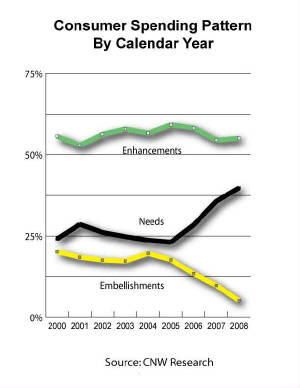|
|
Products: Enhancements or Embellishments How do you classify the products you sell? There are three major classifications of things that consumers
buy: needs, enhancements and embellishments. It is not surprising that during the recession spending for needs accounted for
a larger portion of consumer spending. What is surprising is that spending for enhancements did not lose their share of consumer
dollars. The only loser in the equation was embellishments.
Typically we think of "needs" as the basic goods and services necessary to survive or maintain
a minimal lifestyle. Items like food and shelter are givens when we think of needs. In the US we would add other items based
on how a minimal lifestyle is defined. For instance, in California a vehicle for transportation is considered by many as a
need.
When it comes to enhancements we think of things that make life a little easier, such as a microwave oven. This classification includes items that save us time and effort as we go about our daily lives. Enhancements can help us with our chores around the house, make us more productive at work or play, save us time in our daily commutes or any of a hundred other things we value for the way they smooth out life. Embellishments on the other hand are pure luxury products and services. They go beyond survival or making life a little easier, and the costs involved show it. According to a study by CNW Research, consumer spending on needs dropped from 42.3% in 1980 to a low of 23.1% in 2005. Then in 2006 needs began accounting for a growing portion of household income reaching 39.9% in 2009. During the same time frame embellishments went from 11.6% in 1980 to 19.7% in 2004. In 2005 embellishments began losing share of consumer dollars and in 2009 accounted for only 5.3%. The story for consumer spending on enhancements is somewhat similar but the shifts are much more moderate. In 1980 consumers were spending 46.1% of their income on enhancements, by 2005 that percentage had grown to 59.2%, and by 2009 was at 54.8%. So from its highest point down to last year, enhancements shifted 4.2 percentage points after growing by 13.1. Embellishments on the other hand dropped 14.9 percentage points in its plummet during the recession, while
needs accounted for an increased 15.8 percentage points. During the recession, for the most part, the shift in consumer spending
went from embellishments to needs.
What we have learned is that consumers value enhancements enough to keep spending on them even in the worst recession we have seen in generations. Consumers are inclined to give up products and services that they perceive as luxuries, and have done so the past few years. We all would agree that the vast majority of the products and services offered and sold by the automotive performance parts and accessories industry are not needs-that leaves enhancements or embellishments. The message is obvious. In positioning automotive performance parts and accessories the industry should build the perception that they are enhancements and not luxuries. Of course there are exceptions, but the majority of industry products could be positioned very easily as things that make life a little easier, more productive or rewarding. It seems apparent, that the huge drop in sales the industry saw during the recession was from a large number of mainstream consumers who had entered the market and perceived automotive performance parts and accessories as luxuries. We have always known that to the enthusiast, industry products were not needed but wanted items. Mainstream consumers obviously did not have the same perception. The challenge to the marketing arm of industry companies is to build the perception of industry products and services as enhancements. |
|||||||||||

